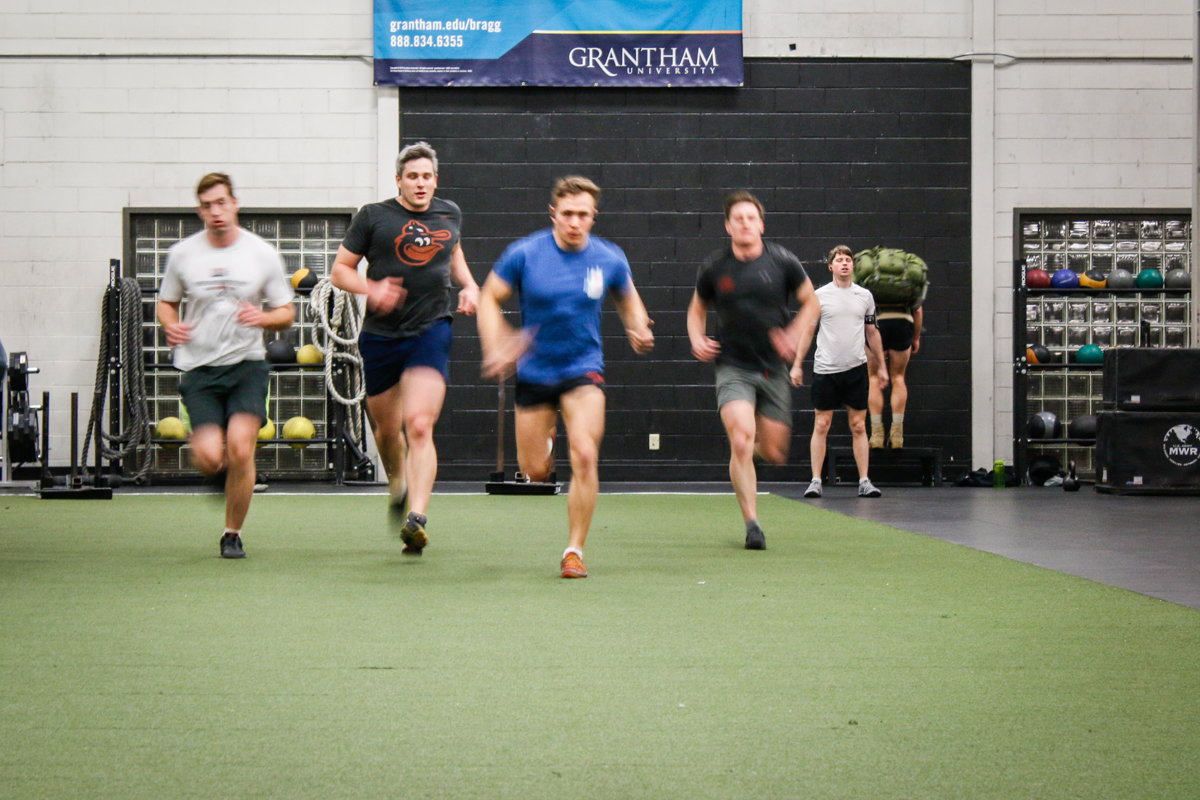
By Adam Scott, MS, CSCS
In 2016, MTI traveled to Fort Bragg, NC for seven days of coaching, research and education.
Our visit included training sessions with students from the US Army Special Forces Qualification Course, current US Army Special Operations soldiers, Cadre at the John F Kennedy Special Warfare Center and School, and a group of specialist from a Joint Special Operations group.
Each group kicked off the week with our Operator Ugly Fitness Assessment. In total, we had 39 athletes complete the test (36 Males and 3 Females). TABLE 1 shows the breakdown of the athletes we worked with.
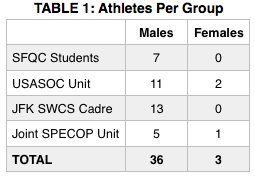
Ultimately, we wanted to use this opportunity to not only compare and contrast different Special Operations Units but also dive deeper into the Operator Ugly Assessment itself. Here are a few of the things we learned:
About Operator Ugly…
If you are not familiar with the Operator Ugly” Fitness Assessment, it is a gym-based test we designed for military operators and tactical professionals. The test consists of 7 events (due to time constraints we only completed the first 6). Each event is scored based on the athlete’s completed repetitions. For more details please click HERE.
Overall, male scores ranged from 71 to 161 points. Female scores (only 3 total) ranged from 79 to 98.5 points.
Much to our surprise, height and weight accounted for only a small portion of final score predictability. A maximum RSquared value of 1.0 means that 100% of score variation can be accounted for by variation in another measure. Height produced a 0.23 RSquared value and weight a 0.36 RSquared value. Age had almost no impact on final score (RSquared = 0.01) – although our age ranges were extremely limited.
The two events which were most predictive of an athlete’s final score were the 95/185# Front Squats (RSquared = 0.70) and Strict Pull-Ups (RSquared = 0.66). TABLE 2 shows the RSquared value for each event we completed.
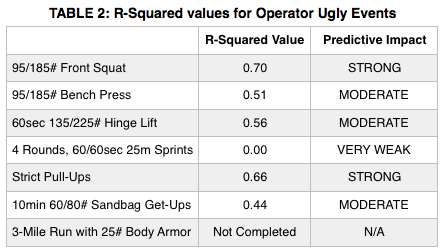
Looking at the above data, two things immediately jump-out – one good and one bad. The first is that individuals with higher lower-body working strength (measured by the front squat) and higher relative upper-body strength (measured by strict pull-ups) will likely score well on the assessment. This is a good sign for the test since we believe that both are vital attributes for tactical athletes.
The second is not so positive. Based on the data, our anaerobic event, the 4 rounds of 60/60sec 25m shuttles, is missing something. With an RSquared value of 0.00, variations in the event have virtually no impact on the final score. Despite observing large variations in aerobic and anaerobic fitness, event scores had a very small range (34-43 shuttles) and thus failed to differentiate between athlete abilities.
On the bright side, now that we know this, we have an opportunity to improve the test to recapture a very important fitness component which we seem to be missing.
Lastly, these tests provided us with an opportunity to begin compiling a database of scores which we can use to develop data-driven standards. Below, in TABLE 3, you can see how the normative scores are stacking up so far.
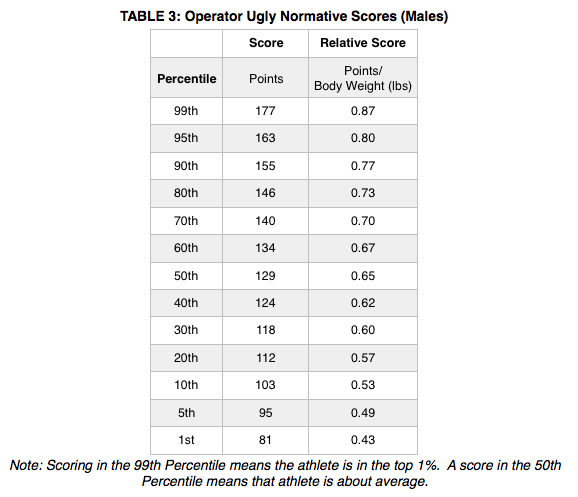
Now, a quick look at the units….
As I mentioned above we ran four different groups through the Operator Ugly Assessment. The groups were all volunteers taken from a specific organization/unit. Outside of being generally healthy, there were no prerequisites for participation. Based on this unscientific “sampling” method, we can’t say that our groups are completely representative of a particular Special Operations population. However, TABLE 4 contains a basic breakdown of the demographics of the groups we worked with – think of it as a snapshot.
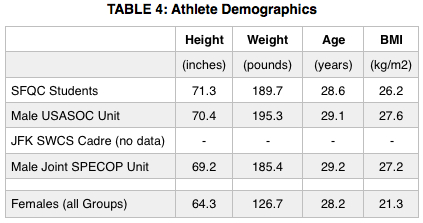
As the table shows, the groups were far more similar than we initially predicted. In fact, using a measure of variation (Cohen’s d), none of the difference was significant.
Much like we saw with the demographics above, Operative Ugly scores between the groups were also fairly similar. Three of the four groups averaged 5.5 points of each other. TABLE 5 shows the total scores for each group and FIGURE 1 shows the break-down by event.
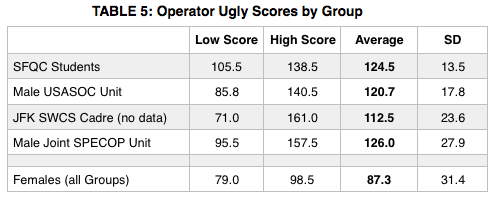

Although overall scores offered little differentiating insight, a deeper look at individual event scores reveals a few more very interesting things.
First, by comparing Front Squat scores to Bench Press scores we can get an approximation of upper and lower body balance. Using this metric we can clearly see differences between the units. The group with the best Front Squat to Bench Press ratio were the SFQC Students (0.90). They were followed by the USASOC Unit (0.71), the cadre (0.65) and then the Joint SPECOP unit (0.54). The females we tested had at the second highest Front Squat to Bench Press ratio at 0.77. It is difficult to say whether these differences are the result of holes in a group’s training or just a product of operational requirements, but it does seem that Q-Course success seems highly dependent on this balance. Additionally, this would be an area we would recommend focusing on if large discrepancies exist.
Another interesting event was the 10-minute Sandbag Get-Ups. This event measures total body “chassis integrity” and mental fitness. Our female participants struggled the most with the event (average = 31 reps). Three of the four groups were relatively similar (average = 38-47 reps) and once again the Q-Course group had the highest average score (55 reps). While sandbag get-ups are definitely not new to our programming, our “chassis integrity” training theory is, but we believe that weakness in this attribute might be highly related to athlete durability.
The last item we wanted to examine was how body weight affected each group. To do this we took the average overall score for the group and divided it by the group’s average body weight. This gave us a relative score (score/body weight). Not surprisingly, these scores were all fairly similar. Interestingly enough the females had the highest ratio (0.69), followed closely by the Joint unit (0.68), the Q-Course students (0.66) and the USASOC unit (0.62). All four groups scored well in this relative measure, but definitely, have room for improvement.
You Might Also Like MTI Essentials – The Operator Sessions
STAY UPDATED
Sign-up for our BETA newsletter. Training tips, research updates, videos and articles - and we’ll never sell your info.
